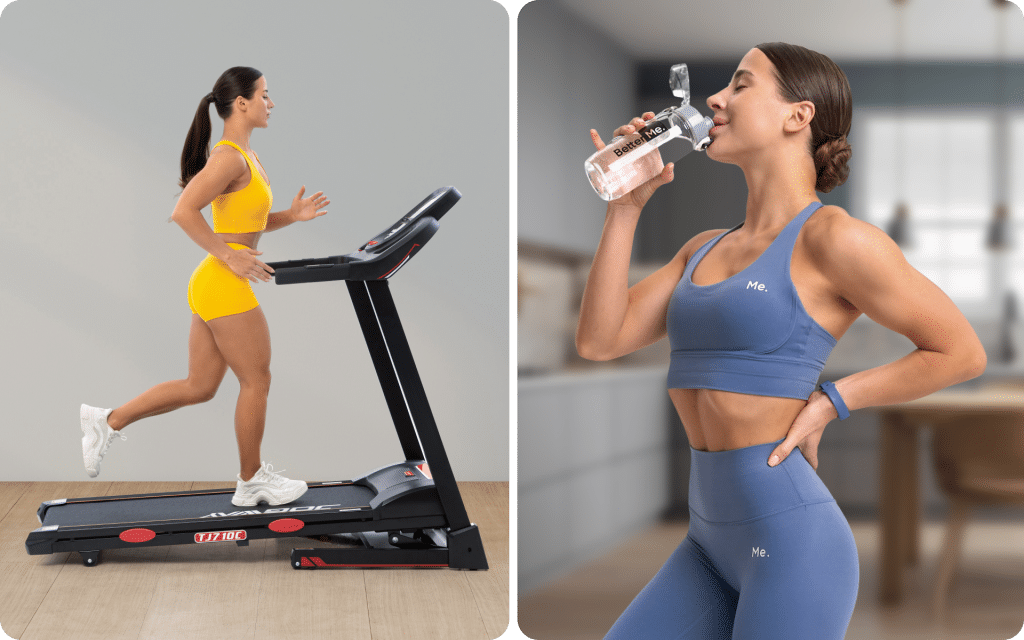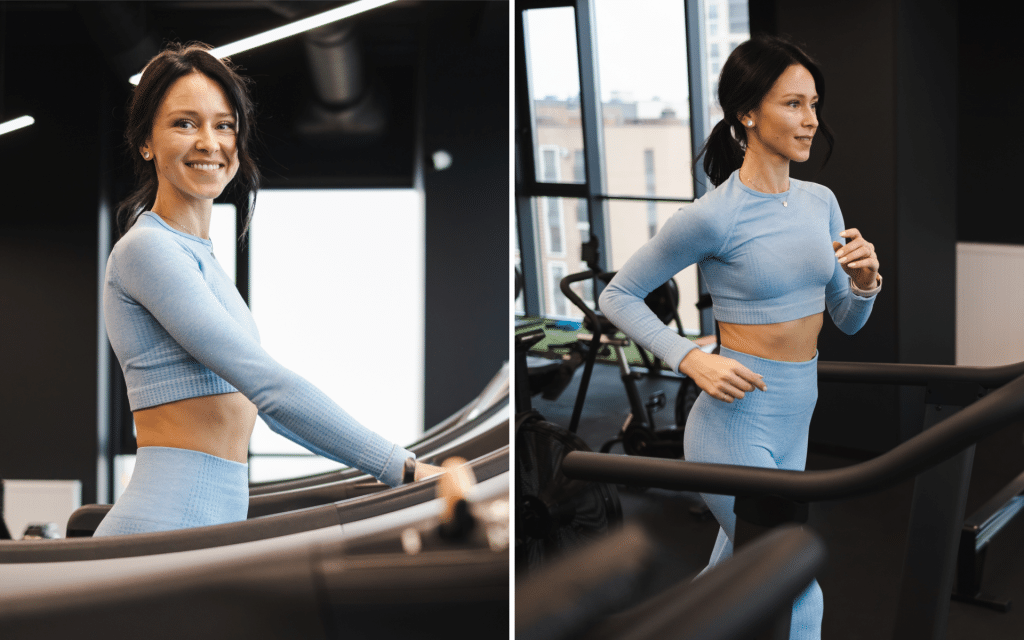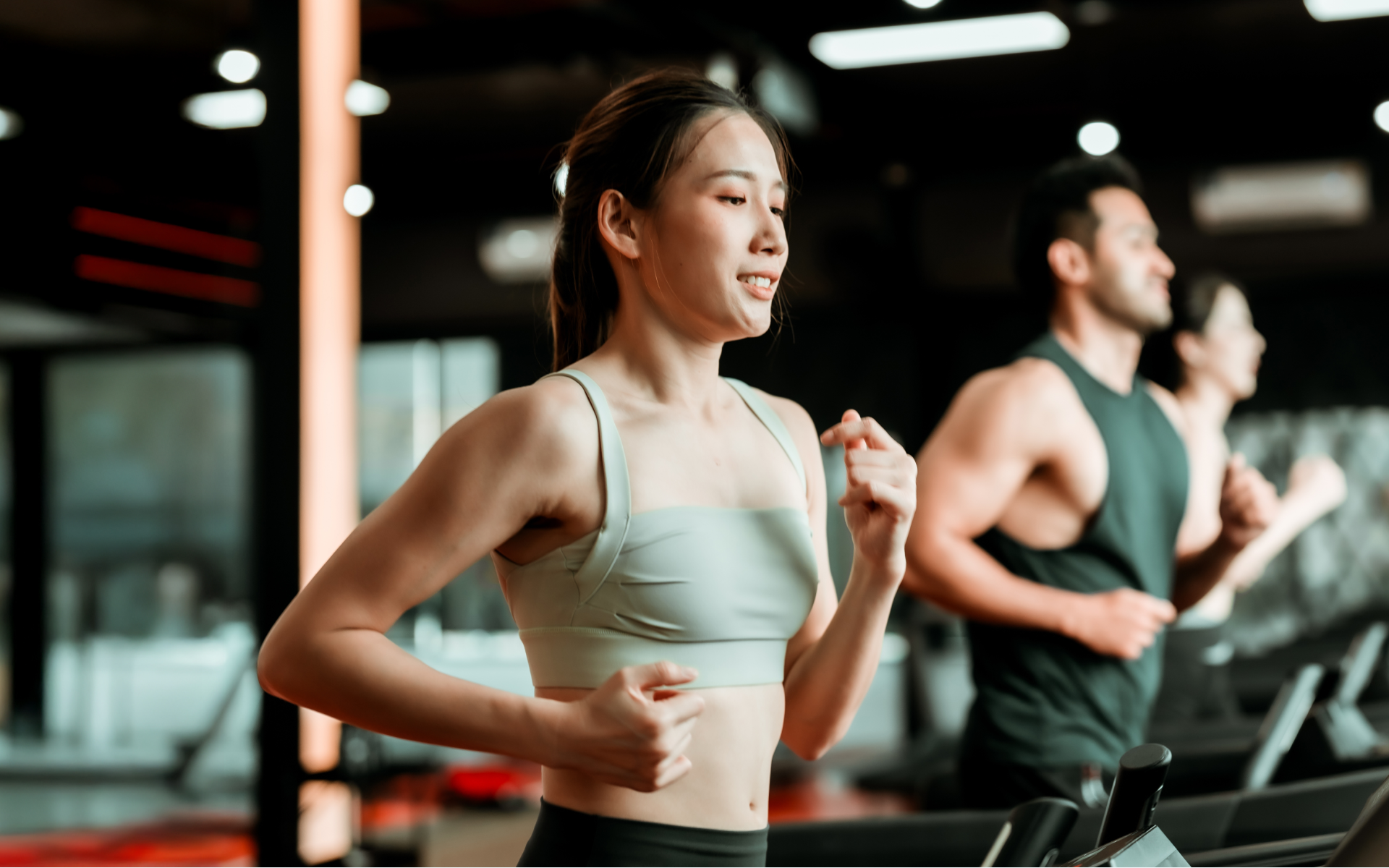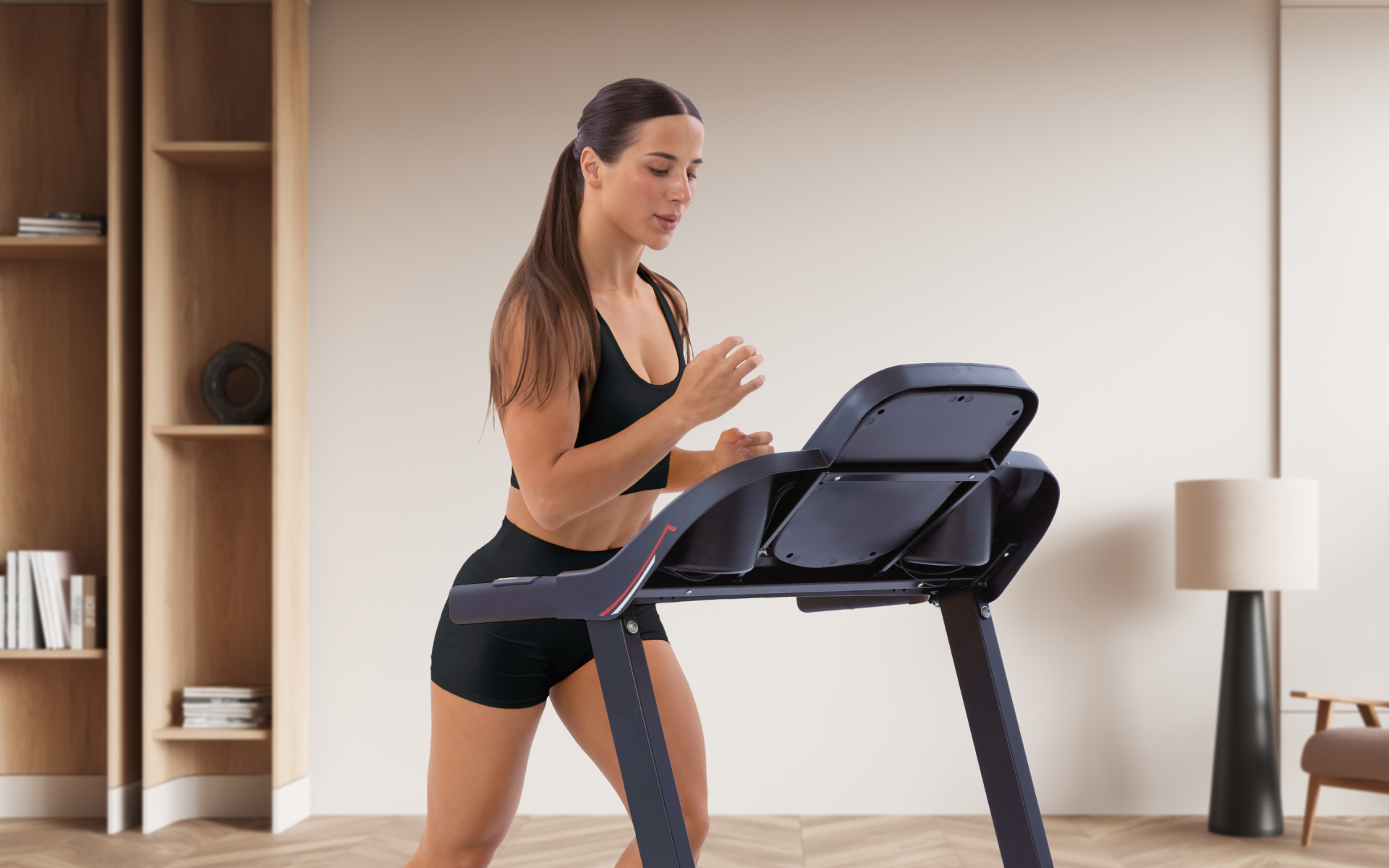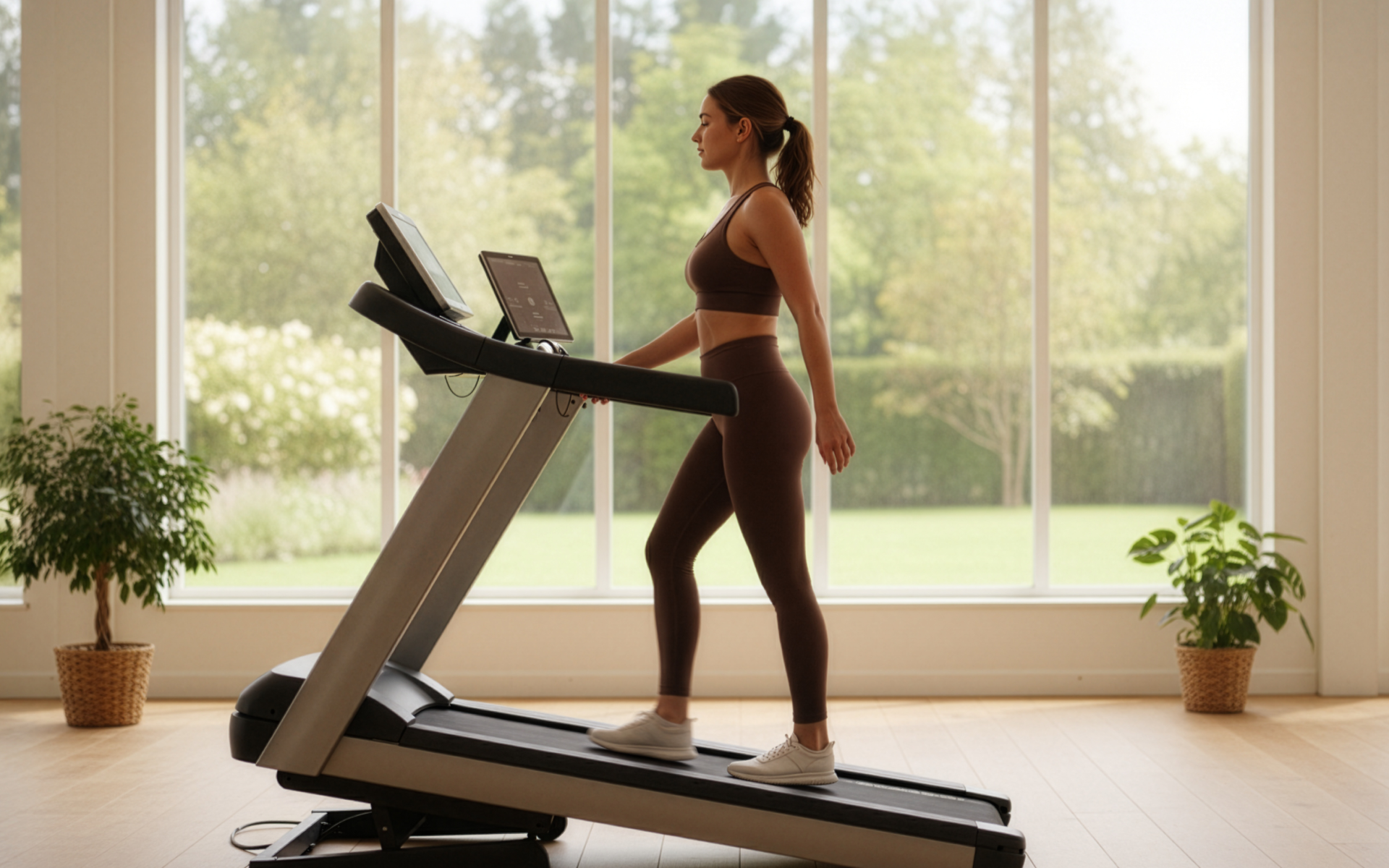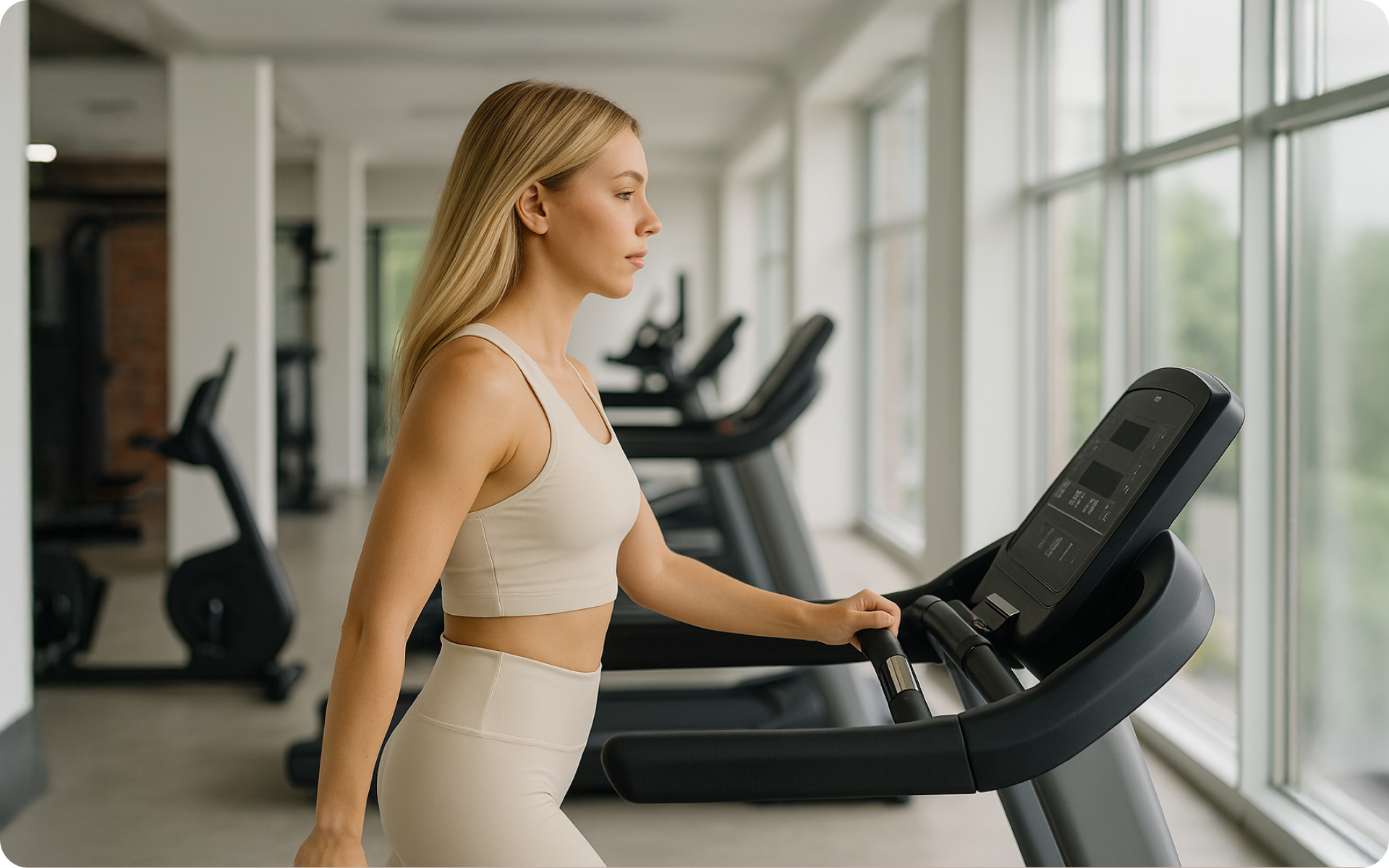Does treadmill build glutes? This question is a surprisingly popular one.
After all, when many of us get on the treadmill, we think of general body, belly fat loss, or building our cardiovascular health, which are scientifically proven benefits of using this exercise machine (1, 2).
While most exercise routines rarely mention treadmill and butt workouts in the same sentence, some research shows that by making a few tweaks to your treadmill walking or running routine, you can target the glute more which could help strengthen and even build your butt.
Read on to learn more about creating the perfect treadmill workout for glutes.
Can I Grow My Glutes On A Treadmill?
Yes, using the treadmill to help grow your glutes is possible.
Treadmill butt workouts may not be the norm but as mentioned above, studies have shown that this machinery can help target your glutes more as you walk or run which over time, may help you build a bigger butt. Scientific evidence that supports this is as follows.
2006
In this study, researchers were trying to determine the role of butt muscles, specifically the gluteus maximus in running. They found that while the muscle is dormant primarily during level and uphill walking, its activity increases greatly during running.
They concluded that the glutes enlarged during evolution to help with running capabilities.
They also stated that as we run, the gluteus maximus works to:
- Control the trunk’s flexion
- Decelerate the swing leg.
- Possibly control flexion of the hip and extend the thigh (3).
While running on the treadmill, your glute muscles are likely activated, i.e., contracting and working.
When it comes to weight loss, progress is made by inches, not miles, so it’s much harder to track and a lot easier to give up. The BetterMe: Health Coaching app is your personal trainer, nutritionist, and support system all in one. Start using our app to stay on track and hold yourself accountable!
2014
In a study published in the Journal of Physical Therapy Science, researchers investigated glute muscle activation while on the treadmill at different inclines.
They found that compared to a 0° treadmill inclination, the glutes appeared more activated at the 5° incline.
However, glute muscle activation significantly decreased while walking at the 10° inclination. The researchers of the 2014 study concluded that walking at a 5° treadmill angle could help strengthen the gluteus medius (4).
Note that the gluteus medius is one of the 3 major muscles located in the butt and it’s between the gluteus maximus and minimus (5).
Pro tip: If you are looking for the best glute exercises to work this muscle directly, one study published in 2020 advised that exercises such as the following worked best to activate the gluteus medius:
- Lateral step-up
- The single-leg bridge
- Side-lying hip abduction with hip internal rotation
- Standing hip abduction on stance
- Swing leg with added resistance
- Resisted side-step (6).
2021
In this study published in The Journal of Physical Fitness and Sports Medicine, researchers were investigating how we can activate muscles in the lower body (i.e., gluteus maximus, gluteus medius, rectus femoris, vastus lateralis, biceps femoris, and lateral gastrocnemius) during uphill sprinting.
The researchers found that humans can highly activate the lower body muscles during the stance phase (when your foot is in contact with the ground/treadmill) of uphill sprinting (7).
While this study looked at how your lower body muscles adapt to the extra effort needed to sprint uphill, we cannot ignore that your glutes are highly engaged while running uphill.
When your muscles are highly activated, they contract and engage more forcefully during physical activity.
Muscle activation leads to:
- Increased muscle strength and power
- Increased athletic performance
- Improved functional movement
- Increased muscle growth
- Improved quality of life
2024
In this study, researchers examined how the glute muscles, specifically the gluteus maximus, were activated during uphill sprint training.
They used 21 male athletes from diverse high-speed sports and found that the gluteus maximus stayed activated throughout the sprinting exercises.
- The left side of the glute experienced the most activation, rising from 57.91% activation to 64.62% activation.
- The right glute’s activation, however, dropped to 35% activation.
The researchers not only found out that inclined or uphill training targeted the glute muscles but also that humans can injure the gluteus maximus during high-speed sports.
It is worth it to find preventative measures to avoid injury, strengthening, and rehabilitation measures in case it happens (8).
Read more: Beginners’ Treadmill Endurance Workout: 30 Minutes Each Day
Which Treadmill Exercise Builds Glutes The Most?
While the treadmill can be a great workout equipment at the gym or at home, there aren’t many workouts to do with it.
The treadmill limits you to different variations and speeds of walking and running (e.g., horizontally, at an incline, or sprinting) and movements like side shuffles or walking lunges.
Of all these workouts, incline or uphill running is the best option for a treadmill glute workout. As seen in the study from the previous section, the researchers found that the glutes became activated when the test subjects did the treadmill exercises at an incline or ‘uphill’ (3, 4, 7, 8).
Additionally, an older study published in the Journal of Applied Physiology found that in horizontal running, the muscle groups that the test subjects primarily activated were:
- The adductors
- Semitendinosus
- Gracilis
- Biceps femoris
- Semimembranosus
However, during incline or uphill running, the most activated muscles included the:
- Adductors
- Biceps femoris
- Gluteal group
- Gastrocnemius
- Vastus group (9).
This examination shows that the muscles in the butt only became activated when the test subject added incline to the exercise.
From these studies, if you’d like to use the treadmill to build your glutes, doing incline walking and especially running could target the glutes more than traditional walking/running, leading to desirable results.
Please Note:
While working out on an incline on the treadmill can help grow your glutes, you are unlikely to see significant results from these workouts alone.
For significant glute gains, exercises that directly target the gluteal group muscles will have better results. We mentioned earlier that the best exercises for the gluteus medius are as follows:
To work the Gluteus Minimus:
- Standing isometric hip abduction
- Hip hitch/pelvic drop variations
- Single-leg bridge
- Single-leg squat (6)
To work the Gluteus Maximus:
- Step-up and its variations (lateral, diagonal, & cross-over)
- Conventional and hex bar deadlift
- Hip thrust variations (rotational barbell, traditional barbell, American barbell, pull-up barbell & band hip thrusts)
- Squat variations (belt squat, split squat, & modified single-leg squat)
- Traditional and in-line lunge (10).
Check out this article for great under butt workout tips and exercises to try.
BetterMe: Health Coaching app helps you achieve your body goals with ease and efficiency by helping to choose proper meal plans and effective workouts. Start using our app and you will see good results in a short time.
Does A Treadmill Reduce Glutes?
Yes, it can. Treadmill exercises are cardio, and such exercises are perfect for reducing fat.
Aside from muscle, the butt also consists of fat and studies show that just 30 minutes of weekly cardio exercises can lead to modest reductions in:
- Body weight
- Waist circumference
- Body fat measures among adults with overweight or obesity.
- The results increase if the duration is 150 minutes a week (11).
What this means is that if you have some extra fat in the buttocks region, engaging in treadmill workouts – as well as eating in a calorie deficit – can lead to fat loss which will eventually lead to having a smaller more visibly muscular butt.
However, engaging in these glute-specific workouts can help increase muscle hypertrophy in this area and can prevent having a flat butt even after losing the excess fat.
Read more: Treadmill Interval Workout Guide For Beginners
What Muscles Do Treadmills Build?
Running on the treadmill targets the muscles in your lower body, namely the quadriceps, hamstrings, glutes, calves, and hip flexors. It also targets your core muscles indirectly.
Here is a great abs and butt workout that you can use to shrink your muffin top and grow your glutes.
How Long Does It Take To Build A Butt?
It is difficult to tell how long it will take each individual to grow their butt through exercise. However, with the right exercises (cardio and weight training, not just butt workouts), a healthy diet with the right amounts of protein, dedication, and consistency, you will typically start seeing initial results within the first 4 to 8 weeks.
It is unlikely that walking will tone your butt, as shown by the studies used in this article, the butt is essentially activated during running and specifically during incline running. Walking does not activate the gluteal muscles (3), so it may not lead to toning this area. For you to see significant gains in your buttocks, it is best to do a variation of exercises rather than just choose one as it may not target all 3 major butt muscles in this area. We have already listed the best exercises for each major glute muscle above. Add 1-2 exercises to your lower body workout routine from each section. Yes, it can. As previously mentioned, running and other aerobic workouts help lose fat. You will eventually have a flat stomach when you remain dedicated to cardio workouts, strength training, and eating on a calorie deficit. Yes, they can. Squats are among the exercises recommended for gluteal growth, especially for the gluteus maximus muscle. Practice progressive overload and eat enough protein for the best results.Frequently Asked Questions
Does walking tone your butt?
What is the best exercise to grow your butt?
Does running give you a flat stomach?
Do squats make your butt bigger?
The Bottom Line
So, does a treadmill build glutes? The treadmill can contribute to glute growth, especially if you run at an incline on the machine.
These exercises are not enough to see significant growth, but are always a good add-on. Significant gains can happen through a healthy high-protein diet, incline treadmill workouts, and lower body weight training exercises.
DISCLAIMER:
This article is intended for general informational purposes only and does not serve to address individual circumstances. It is not a substitute for professional advice or help and should not be relied on for making any kind of decision-making. Any action taken as a direct or indirect result of the information in this article is entirely at your own risk and is your sole responsibility.
BetterMe, its content staff, and its medical advisors accept no responsibility for inaccuracies, errors, misstatements, inconsistencies, or omissions and specifically disclaim any liability, loss or risk, personal, professional or otherwise, which may be incurred as a consequence, directly or indirectly, of the use and/or application of any content.
You should always seek the advice of your physician or other qualified health provider with any questions you may have regarding a medical condition or your specific situation. Never disregard professional medical advice or delay seeking it because of BetterMe content. If you suspect or think you may have a medical emergency, call your doctor.
SOURCES:
- Effects of inclined treadmill training on functional and cardiovascular parameters of stroke patients: study protocol for a randomized controlled trial (2019, trialsjournal.biomedcentral.com)
- Maximal Fat Oxidation: Comparison between Treadmill, Elliptical and Rowing Exercises (2021, pmc.ncbi.nlm.nih.gov)
- The human gluteus maximus and its role in running (2006, journals.biologists.com)
- Comparison of the Activity of the Gluteus Medius According to the Angles of Inclination of a Treadmill with Vertical Load (2014, pmc.ncbi.nlm.nih.gov)
- Anatomy, Bony Pelvis and Lower Limb, Gluteus Maximus Muscle (2023, ncbi.nlm.nih.gov)
- A SYSTEMATIC REVIEW AND META-ANALYSIS OF COMMON THERAPEUTIC EXERCISES THAT GENERATE HIGHEST MUSCLE ACTIVITY IN THE GLUTEUS MEDIUS AND GLUTEUS MINIMUS SEGMENTS (2020, pmc.ncbi.nlm.nih.gov)
- Effect of incline on lower extremity muscle activity during sprinting (2021, researchgate.net)
- Unveiling the Dynamics: Kinematics and Activation Patterns of Gluteus Maximus in Inclined Treadmill Sprinting (2024, researchgate.net)
- Lower extremity muscle activation during horizontal and uphill running (1997, journals.physiology.org)
- Gluteus Maximus Activation during Common Strength and Hypertrophy Exercises: A Systematic Review (2020, pmc.ncbi.nlm.nih.gov)
- Aerobic Exercise and Weight Loss in Adults A Systematic Review and Dose-Response Meta-Analysis (2024, jamanetwork.com)



